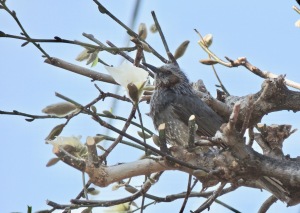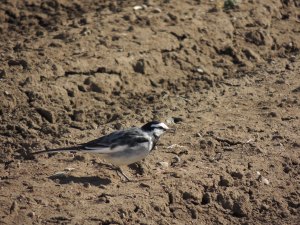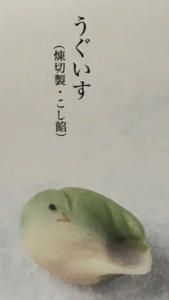I see birds everywhere in west Tokyo. They are in my garden and in the farmer’s fields outside our windows. Before the pandemic, I walked to the grocery store or to the station every day so I would see them in the trees along the street, in garden trees, and on buildings. I would take the camera with me (before cellphones) and I would take walks just to photograph them. So naturally, birds have shown up in my writing. My middle grade novels are set in my neighborhood in west Tokyo.
Here are the birds of my second novel, BEYOND ME, coming out on June 30, 2020. Click on my photos to look more closely, but also click on the link below each photo to see photos at Cornell Lab’s eBird. Be sure to click on “Listen” on their page. You can hear what I hear almost every day.
White-cheeked Starlings (Spodiopsar cineraceus) come to the fields to forage for insects. One starling always followed or led our neighborhood farmer as he tilled his field. Was it the same one every day? Every year? I am not sure. The farmer has retired. I still see starlings. But none follow the farmer who rents the field. Big flocks of them sit on the wires every fall. White-cheeked Starling on eBird.
I was thinking of Chinese Hwamei (Garrulax canorus) for the bird that disrupts Maya’s class choir practice. I hear them but have only seen one. High in a tree at sunset, this bird sang its heart out. (Made my heart sing.) Sadly, this photo is not good. Chinese Hwamei on eBird.
Eurasian Tree Sparrows (Passer montanus) are here through all the seasons. They are hard to photograph. They move fast in a flock. Eurasian Tree Sparrow on eBird.
Brown-eared Bulbuls (Hypsipetes amaurotis) visit our garden in the winter and eat the mikan or apple I put in the tree. They eat the last of the farmer’s broccoli.
They also shred the blossoms of the magnolia trees along the main street. Brown-eared Bulbul on eBird, in Japan Times.
Rock Pigeons (Columba livia) are also called Common Pigeons. Our neighborhood barber’s wife fed a flock of about ten before they closed their shop. The Rock Pigeons used to spend their days in the tree in a tree lot next to the barber shop. I miss them. Here is one sitting on an air conditioning unit. Rock Pigeon on eBird.
White Wagtails (Motacilla alba lugens) zig and zag and wag through the farmer’s fields every season. In a recent interview with the Audubon Society, Jane Goodall said she liked Robins and Wagtails. I like them too. Wagtails are fun to watch. There is another wagtail that visits the fields called the Japanese Wagtail (Motacilla grandis). I don’t see them as often. White Wagtail on eBird.
Oriental Turtle Doves (Streptopelia orientalis) never come to our garden anymore after a crow got a turtle dove nest. They sit on fences or in trees. There are usually two turtle doves together. This one is always along. On the day of this photo, a Eurasian Sparrow was sitting on the fence nearby. Oriental Turtle Dove on eBird.
Japanese Bush Warblers (Horornis diphone) are heard but rarely seen. They are a sign of spring. I don’t have a photo of one! Here is a photo of a wagashi dessert shaped like a Japanese Bush Warbler. Japanese Bush Warbler on eBird.
Barn Swallows (Hirundo rustica) nest on houses and store fronts. We’ve never had a barn swallow on our house. As I walk to the grocery store in April to July, barn swallows might duck under the awning of the neighborhood Chinese restaurant, the laundromat and the florist and the bank near the station. The skies above the shopping street get busy!
Here is a description from The Japan Times by Rowan Hooper. Barn Swallows on eBird.

Large-billed Crow, Hashibuto-garasu ハシブトガラス Most people call them Karasu カラス. field of trees December 17, 2014
Large-billed Crows (Corvus macrorhynchos japonensis) come to the fields. Families come at the end of summer and stay until the beginning of summer. I love watching them. They don’t always come or stay in a group. Mostly they come alone or with another to scout for food. This one posed for me in a tree across from the farmer’s field. I have many videos of them. Large-billed Crow on eBird.
I have many photos of birds dating back to 2006. Recently, I started uploading them with the time, date and details to Cornell Lab’s online database, e-Bird. The data may help scientists know bird populations and bird patterns.
(My list isn’t public yet. I am still working on it.)











